
A spa town is a resort town based on a mineral spa. Patrons visit spas to "take the waters" for their purported health benefits.

Pontevedra is a Spanish city in the north-west of the Iberian Peninsula. It is the capital of both the Comarca (County) and Province of Pontevedra, and of the Rías Baixas in Galicia. It is also the capital of its own municipality which is often considered an extension of the actual city.

Freguesia, usually translated as "parish" or "civil parish", is the third-level administrative subdivision of Portugal, as defined by the 1976 Constitution. It is also the designation for local government jurisdictions in the former Portuguese overseas territories of Cape Verde and Macau. In the past, was also an administrative division of the other Portuguese overseas territories. The parroquia in the Spanish autonomous communities of Galicia and Asturias is similar to a freguesia.

Cascais is a town and municipality in the Lisbon District of Portugal, located on the Portuguese Riviera. The municipality has a total of 214,158 inhabitants in an area of 97.40 km2. Cascais is an important tourist destination. Its marina hosts events such as the America's Cup and the town of Estoril, part of the Cascais municipality, hosts conferences such as the Horasis Global Meeting.
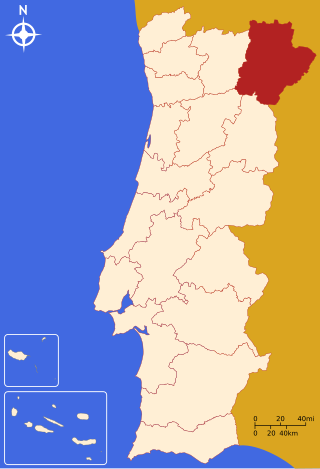
Bragança District is a traditional political division of Portugal, in the northeast corner bordering on Spain, covering 7.4% of the nation's continental landmass. As of the 2011 census the total resident population was 136,252, making it the second-least populous district in Portugal, only surpassing Portalegre District.

Vila Real de Santo António is a city, civil parish, and municipality in the Algarve, Portugal. The population in 2011 was 19,156, in an area of 61.25 km2. It is one of the few municipalities in Portugal without territorial continuity: its territory comprises two parts, with the municipal seat located in the eastern part. Vila Real de Santo António was founded after the 1755 Lisbon earthquake, and largely expanded in 1774 using the same architectural and construction techniques employed in the reconstruction of Lisbon after the disaster.
Valladares is a notable family name originating in the ancient land of Valadares, situated next to Melgaço. It is the northernmost municipality in Portugal, on the south bank of the Minho River, which separates Portugal and Galicia. Because of the proximity of northern Portugal and Galicia, the early Valadares can be found on both sides of the border. The first titled member of the Valladares nobility in Galicia was Luis Sarmiento de Valladares, the first viscount of Meira in 1669 and first marquis de Valladares 1673, the latter title granted by King Charles II of Spain in the second half of the 17th-century. The Valladares family are also very popular in Central America specifically in Honduras, El Salvador, Mexico and in Brazil as well.
Fitero is a town and municipality located in the province and autonomous community of Navarre, northern Spain.

Caminha is a municipality in the north-west of Portugal, 21 km north from Viana do Castelo, located in the Viana do Castelo District. The population in 2011 was 16,684, in an area of 136.52 km².

Mondariz is a town and municipality in the province of Pontevedra, autonomous community of Galicia, Spain. It has a population of 4,440 inhabitants.
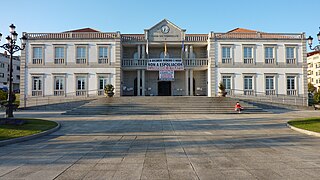
Salvaterra de Miño is a town and municipality (concello) in the province of Pontevedra, autonomous community of Galicia, Spain. It's located on the southern border of the province of Pontevedra, at the confluence of the valleys of the rivers Tea and Minho, and by the natural limits of the Serra da Cañiza. It borders the Municipalities of As Neves in the east, Mondariz and Poteareas to the north, and to the south by the Minno river. The Minno river is the southern natural border that today separates Portugal with its fortified town of Monção from current Galicia to the north.
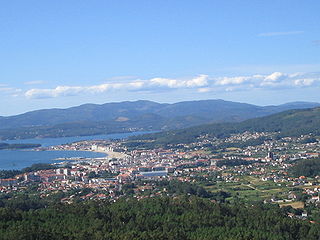
Vilagarcía de Arousa is a Spanish municipality in the Province of Pontevedra, Galicia. As of 2014 it has a population of 37,712, being ninth largest town in Galicia.

Cambre is a municipality in the Province of A Coruña, in the autonomous community of Galicia in northwestern Spain. It is located 12 km from the capital city of A Coruña and ten minutes away from the city's airport, Alvedro.
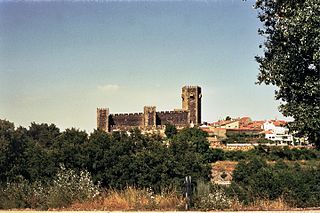
Sabugal is a city and a municipality in the District of Guarda, Portugal. A border municipality with Spain, the population of the municipality in 2011 was 12,544, in an area of 822.70 km2. The city proper, located along the Côa river, has a population of about 3,000 inhabitants. There is a castle in the city of Sabugal proper as well as other castles outside the urban centre in a number of places around the entire municipality of Sabugal. Those are the castles of Sortelha, Alfaiates, Vilar Maior and Vila do Touro. The municipal holiday is the Monday after Octave of Easter. It is also place for the Sabugal Dam built in 2000 and the river beach of Devesa, both located in the Côa river. At an elevation of roughly 750 m (2460 ft) above sea level, Sabugal is among the highest cities in Portugal.

Praia da Luz, officially Luz, is a civil parish of the municipality of Lagos, in Algarve region, Portugal. The population of the civil parish in 2011 was 3,545, in an area of 21.78 km2. Also known as Santorini de Portugal, Luz de Lagos or Vila da Luz, "Praia da Luz" is used to refer to both the urbanized village and the beach. The parish had its origins in a small fishing village, but was transformed by several holiday-villa complexes into a tourist area.
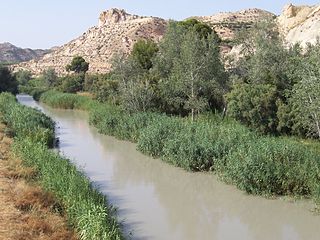
Archena is a municipality of Spain in the province of Murcia and is located in the northeastern quarter. It has a population of 18,496 and an area of 16.5 km2 (6.4 sq mi). It is 24 km (15 mi) away from the provincial capital, Murcia.
Vilasobroso is a small village in the southwest of Galicia, Spain. It is both an ecclesiastical parish within the municipality of Mondariz, known as San Martiño de Vilasobroso, and an administrative lesser local entity. As an lesser local entity it is only one of nine administrative divisions directly below a municipality in the whole of Galicia. According to the 2008 census the village has a population 367.

A balneario is an Iberian and Latin American resort town, typically a seaside resort, and less commonly along the shores of lakes and rivers or next to hot springs. In Spain, balneario typically only refers to spa town resorts. These resorts offer recreation, sports, entertainment, food, hospitality and safety services, retail, and cultural events. These balneario towns are characterized by being flooded by masses of tourists during the summer seasons.

The Island of A Toxa,La Toxa Grande, the Island of Louxo or the Island of the Baths of Louxo is a Spanish island belonging to the province of Pontevedra, in Galicia. The island is located east of the small town of O Grove, to which it is connected by an 18th-century bridge · It has a small urban centre called Isla de la Toja, belonging to the civil parish of San Martín, which had 42 inhabitants in 2018. It has an area of 110 hectares and is located about 30 km from Pontevedra.






















